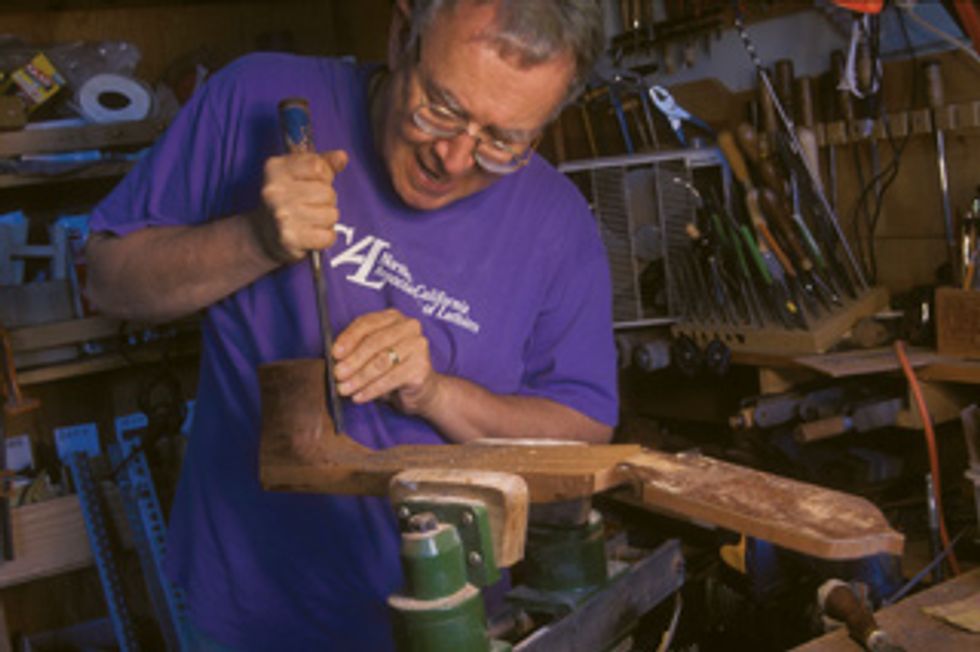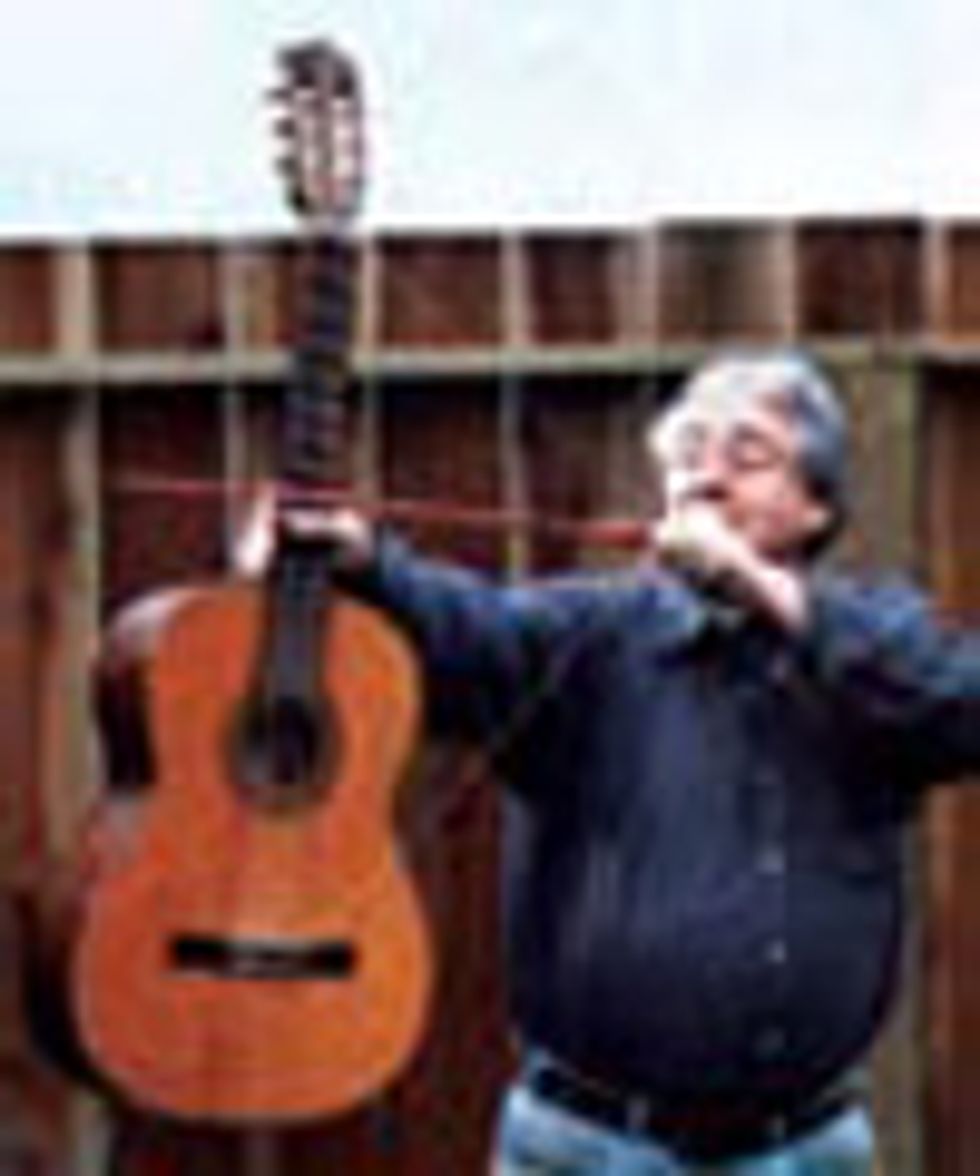
More trivia: What’s wrong with this picture?
As guitarists, we pick up an amazing amount of specialized knowledge about our instruments, technique, equipment, and, of course, music itself. But there’s always more to learn, right? If you ever find yourself in need of some guitar trivia—perhaps on a long van ride home from a weekend gig—here are some nuggets you can trot out when you need to perk up a conversation or keep the driver awake.
For example, all woodworkers know what a kerf is—it’s the space made by the path of a saw blade through a piece of material that is being cut. Most people don’t realize that kerfs are the only known things in the universe that get bigger and bigger until they disappear. Think about it: Other things only get smaller until they disappear. This is exactly the kind of trivial fact that will, if used properly, make you a sure success on your next date. Or at least entertain the driver for those last 50 miles.
Lutherie is the work of luthiers: It’s the making of stringed musical instruments. Lutherie derives from the French luthier, meaning lute-maker, obviously from before the time that guitars were being made. While luthier originally meant a maker of stringed instruments—and specifically fretted stringed instruments (as opposed to harps, violins, and pianos)—it has more lately come to be used to designate pretty much any kind of musical instrument maker, including wind instruments, harpsichords, etc.
It is from the Mongols, acknowledged as the world’s finest horsemen, that so much equine imagery has come into use when talking about stringed instruments. The head, neck, body, and saddle are terms first used by the Mongols to describe those parts of the instrument. As the world’s finest archers (think bows), the Mongols were also responsible for the violin family as we know it.
Padouk is a beautiful red hardwood that’s sometimes used in guitar making. Its proper name is Andaman padouk, as it grows only on the Andaman Islands that lie halfway between India and Malaysia in the Indian Ocean. Padouk is, in fact, the islands’ only resource of any commercial interest. Years ago, when England had a worldwide empire, the British established a penal colony on these sweltering tropical islands, whose sole work was the logging and harvesting of this special wood. Commercial logging of padouk is no longer done with convict labor, but it’s hard for me to see a plank of this lovely material without thinking of the poor creatures who were once forced to sweat out their lives in cutting it. Also, it makes me think that other woods we use probably have interesting stories behind them, too. Something to think about in today’s world of resource conservation and global trade.
And speaking of wood: Hardwoods and softwoods are not named because they are actually hard or soft. Taxonomists have labeled them according to the shapes of their leaves. Softwoods are, by definition, trees that have long, thin leaves; hardwoods are identified by their broad, flat leaves. The fir that your flooring may be made of, a material that can stand up to many years of use, is a softwood. On the other hand, balsa wood is a hardwood.
Balsa wood, which some luthiers use for bracing, is a South American tropical hardwood named for its use and not its discoverer nor its Latin name. Balsa, in Spanish, means raft. Raft-wood is simply the tree that people made rafts out of since the time they first noticed that it wasn’t all that good for flooring.
Guitar makers work with woods from all over the world—it’s one of nature’s most plentiful resources. England, however, has rather little of it: It is, in fact, Europe’s only wood-importing country. England used to be mostly covered by forests (remember Sherwood Forest and Robin Hood?), but from the 17th century on, its forests were systematically cut down to serve the needs of the Industrial Revolution—which that country gave birth to.
For one thing, raw wood was needed to construct England’s growing cities, and also to build ships for navies of war, commerce, trade, and exploration. Second, huge amounts of coal and firewood were needed to stoke the furnaces of the growing iron and glass-working industries. As the ground was dug up and trees were cut down, the forests began to disappear. Simultaneously, English landowners found that raising sheep on their lands to supply the textile industry’s ravenous need for wool was more profitable than having peasant farmers on it, so they further cut their lands bare to make pastures for sheep and thereby displaced the traditionally rural peasant population into the cities, where it could provide the labor pool for the Industrial Revolution’s workforce.
The upshot of such deforestation was that the English soil became rapidly denuded of its natural protective cover, and erosion on a ferocious scale became, for the first time, a fact of life. Floods and flooding in towns became common events—so much so that drowned domestic animals were often found lying on the ground after a storm had passed. This has given us the phrase about a downpour so intense that it rained cats and dogs.
A computerized survey of medical records has shown that 69 percent of piano players suffer back pain. That’s bad. But not as bad as the 73 percent of the harpists who hurt similarly. You’re better off as a guitarist, according to the same survey: Only 33 percent of us voice that complaint.
Good luck on your next date or road trip! With any luck it will produce an anecdote or odd bit of knowledge worth writing down. And if you know other guitar-related trivia to add to this list, I’d love to hear it.
 Ervin Somogyi has been a professional luthier since the early 1970s and is one of the world’s most
respected acoustic-guitar builders and
rosette designers. To learn more about
Somogyi, his instruments, or his rosette and
inlay artwork, visit esomogyi.com.
Ervin Somogyi has been a professional luthier since the early 1970s and is one of the world’s most
respected acoustic-guitar builders and
rosette designers. To learn more about
Somogyi, his instruments, or his rosette and
inlay artwork, visit esomogyi.com.







![Rig Rundown: Russian Circles’ Mike Sullivan [2025]](https://www.premierguitar.com/media-library/youtube.jpg?id=62303631&width=1245&height=700&quality=70&coordinates=0%2C0%2C0%2C0)








